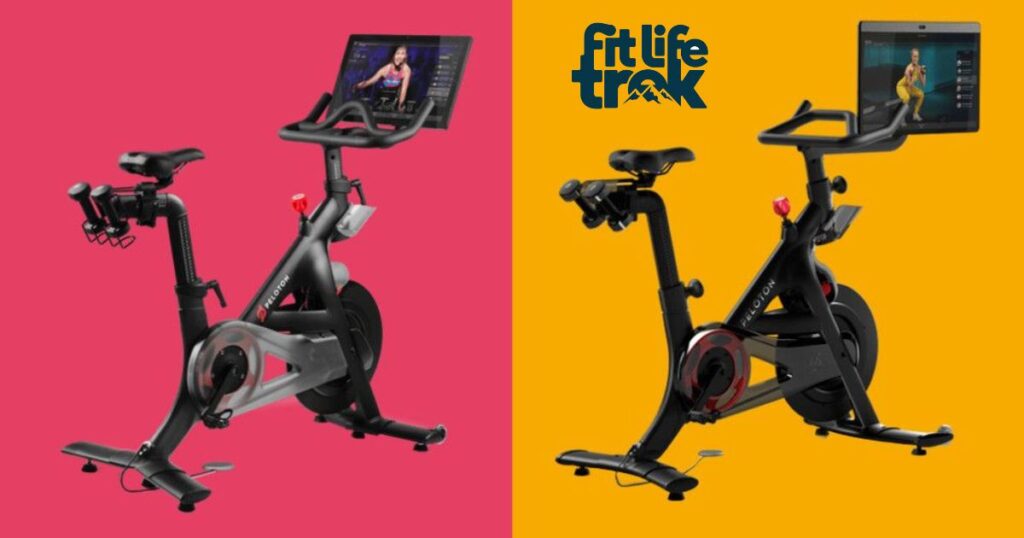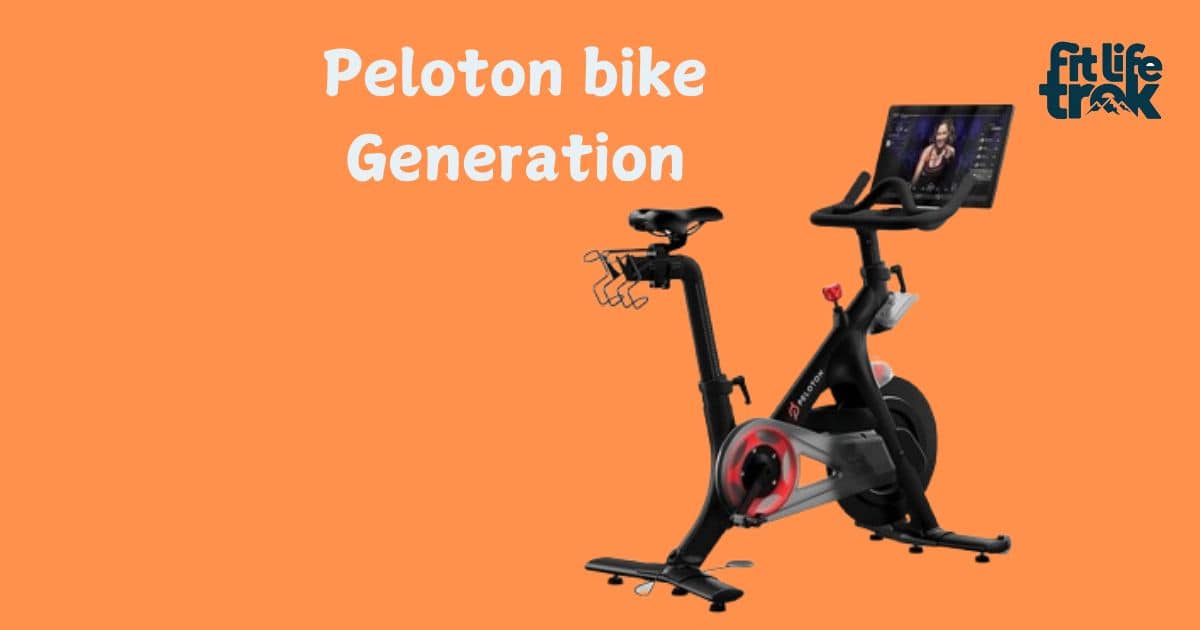Peloton bike generations represent the evolution of this popular exercise equipment. The Peloton generation 4 was released in late 2018, bringing improved software and hardware capabilities. This update enhanced the user experience and introduced gradual improvements to the bike’s overall functionality.
The differences between generations can help you make an informed decision. Each new generation brings exciting features and improvements that could enhance your workout experience.
Determining your Peloton bike’s generation is easier than you might think. By examining the model number, screen size, and available features, you can identify which generation you have. This knowledge can help you understand your bike’s capabilities and decide if an upgrade might be beneficial for your fitness goals.
What are Peloton bikes?

Peloton bikes are more than just fancy stationary bicycles. They’re high-tech fitness companions that have revolutionized home workouts. Born from the idea of bringing studio-style classes into your living room, Peloton has grown into a fitness phenomenon that’s changing the way people approach exercise.
During the COVID-19 pandemic, Peloton saw a surge in popularity. With gyms closed, people turned to these smart bikes for their fitness fix. The Peloton Bike and Peloton Bike Plus became the go-to options for those seeking a challenging workout from the comfort of home.
But what makes these bikes so special? It’s their ability to connect riders with world-class instructors and a global community of fellow fitness enthusiasts, all through the power of technology.
Peloton Bike: The Original Game-Changer
The original Peloton Bike hit the market in 2014, turning heads with its sleek design and innovative features. It’s not just a bike; it’s a portal to a world of interactive fitness classes. The Peloton Bike comes equipped with a 21.5-inch HD touchscreen that brings instructors and fellow riders into your home, creating an immersive workout experience like no other.
This bike is perfect for cycling enthusiasts who want to focus on cardio workouts. It offers a range of classes, from beginner-friendly rides to intense hill climbs. The resistance knob lets you control the intensity, making it suitable for all fitness levels. Whether you’re a seasoned cyclist or just starting out, the Peloton Bike offers a customizable experience that grows with you.
Peloton Bike Plus (+)
In 2020, Peloton upped the ante with the Peloton Bike Plus. This advanced model takes everything great about the original and kicks it up a notch. The star of the show is the larger 23.8-inch anti-glare HD touchscreen that rotates 360 degrees, opening up a whole new world of workout possibilities.
The Bike+ isn’t just for cycling. Its rotating screen allows you to hop off the bike and join floor workouts seamlessly. With enhanced speakers and automatic resistance adjustment, the Bike+ offers a more immersive and versatile workout experience.
It’s designed for those who want a full-body workout solution, not just a cycling machine. The Bike+ represents Peloton’s vision of a comprehensive home gym, all centered around one sleek piece of equipment.
What is the difference between generations of Peloton bikes?

The differences between Peloton bike generations is key to choosing the right model for you. Let’s break it down in more detail:
- Display: The original Bike has a fixed screen that tilts, allowing you to adjust the viewing angle for comfort during rides. The Bike+, however, boasts a 360-degree rotating display. This feature is game-changing for those who want to incorporate strength training, yoga, or stretching into their routine, as you can easily swivel the screen for off-bike workouts.
- Resistance: On the original Bike, resistance is adjusted manually using a knob. While effective, it requires you to make changes yourself during workouts. The Bike+ introduces auto-resistance, a feature that automatically adjusts the resistance to match the instructor’s cues. This allows for a more immersive experience, letting you focus on your form and effort rather than fiddling with controls.
- Speakers: Sound quality can make or break a workout experience. The Bike comes equipped with 2×10 watt rear-facing speakers, which provide clear audio for your classes. The Bike+ upgrades to 2×20 watt front and rear-facing speakers, creating a more immersive sound experience that makes you feel like you’re right in the studio with your instructor.
- Touchscreen: The Bike features a 21.5-inch HD touchscreen, which is impressive in its own right. The Bike+ steps it up with a larger 23.8-inch anti-glare HD touchscreen. The anti-glare feature is particularly useful if your workout space gets a lot of natural light, ensuring you can always see your instructor and metrics clearly.
- Price: The Bike is more budget-friendly, making it an excellent entry point into the Peloton ecosystem. The Bike+ comes at a premium for its advanced features, but many find the additional capabilities worth the investment.
- Training: Both offer excellent cardio workouts through cycling classes. However, the Bike+ is designed for a more comprehensive fitness experience. Its rotating screen and enhanced features make it easier to engage in a variety of workout types, including strength training, yoga, and boot camp classes.
Here’s a detailed comparison table to help you visualize the differences:
| Feature | Peloton Bike | Peloton Bike Plus (+) |
| Display | 21.5″ fixed, tiltable | 23.8″ rotating |
| Resistance | Manual | Auto-follow available |
| Speakers | 2×10 watt rear-facing | 2×20 watt front and rear-facing |
| Screen | 21.5″ HD touchscreen | 23.8″ anti-glare HD touchscreen |
| Price | $1,445 | $2,495 |
| Focus | Primarily cycling | Multi-discipline fitness |
| Apple GymKit | Not compatible | Compatible |
| Processor | 2.0 GHz MediaTek MT8173 | 2.5 GHz Qualcomm QCS605 |
| RAM | 2 GB | 4 GB |
| Camera | 5 MP | 8 MP |
What are the screen generations of Peloton bikes?
The evolution of Peloton bike screens is a journey through technological advancement. Each generation brought new features and improvements, enhancing the user experience and capabilities of the bikes:
Generation 1
The first Peloton Bike screen was a game-changer. It introduced riders to the world of interactive fitness with its 21.5-inch HD touchscreen. This screen ran on Android Jelly Bean 4.1.1 and offered a basic but functional interface for accessing Peloton’s growing library of classes. While revolutionary at the time, it had limitations in terms of processing power and features compared to later generations.
Generation 2
Improvements:
- Upgraded to a 22-inch screen
- Switched to Android Lollipop 5.1
- Later updated to Android 7.0
Generation 2 screens brought a smoother user experience. The slightly larger screen and updated operating system made navigating classes and metrics easier. The update to Android 7.0 in 2016 was a significant boost, bringing improved stability and performance to the Peloton ecosystem.
Generation 3
Improvements:
- Introduced Bluetooth support
- Enhanced audio quality
- Improved overall user experience
This generation was a significant leap forward. Bluetooth connectivity allowed riders to pair heart rate monitors and wireless headphones, creating a more personalized workout experience. The enhanced audio quality made instructor cues clearer and music more motivating, contributing to a more immersive ride.
Generation 4
Improvements:
- Further refined software capabilities
- Enhanced hardware for better performance
- Improved user interface responsiveness
Generation 4 screens focused on optimizing the user experience. Faster response times and smoother animations made interacting with the bike feel more natural and intuitive. This generation saw improvements in the bike’s ability to handle more complex graphics and faster loading times for on-demand classes.
Generation 5
Improvements:
- Latest software updates
- Enhanced interactive features
- Improved processing power
The current generation of Peloton Bike screens represents the pinnacle of the company’s technology. These screens offer the most seamless and immersive experience yet, with lightning-fast responses and crystal-clear visuals. The improved processing power allows for smoother video streaming and quicker transitions between different sections of the Peloton app.
What are the generations of screens of Peloton Bike Plus?

The Peloton Bike Plus has seen two generations of screens, each offering significant improvements:
Gen 1 (2AA3N-TTR01)
Improvements:
- Introduced 23.8-inch rotating touchscreen
- Added front-facing speakers and rear subwoofers
- Enhanced sound quality for immersive audio experience
The first generation of Bike+ screens was a major upgrade from the original Bike. The larger, rotating screen opened up new possibilities for off-bike workouts. The improved audio system with front-facing speakers and rear subwoofers created a more studio-like experience, making users feel more connected to their instructors and the music.
Gen 2 (2AA3N-TTR02)
Improvements:
- Further enhanced display quality
- Expanded workout options
- Improved overall user experience
The second generation refined the Bike+ experience, offering even better visuals and a more robust selection of classes and features. The enhanced display quality makes metrics easier to read and instructor cues clearer. The expanded workout options take full advantage of the rotating screen, offering a more comprehensive fitness experience beyond just cycling.
Which Peloton generation is best to buy?

Choosing the right Peloton bike generation depends on your fitness goals, budget, and technological preferences. Here’s a more detailed guide to help you decide:
- Workout only: If you’re just looking to ride and don’t need the latest bells and whistles, the original Bike or an early generation screen will suffice. These models still offer excellent cycling workouts and access to Peloton’s extensive class library.
- Training only: For those wanting instructor-led classes with good video quality and a smooth user interface, any generation from 2 onwards will provide a great experience. These generations offer improved software and hardware capabilities that enhance the training experience.
- Tracking your workout: If metrics are important to you and you want to connect with other fitness devices, opt for Generation 3 or later. These models offer better connectivity with fitness trackers and heart rate monitors, allowing for more comprehensive workout data.
- Enhanced User Experience: For the latest features, best performance, and most immersive experience, go for the newest generations of either the Bike or Bike+. These models offer the smoothest user interface, fastest processing, and most advanced features like auto-resistance and rotating screens.
How do I find the generation of your Peloton Bike?
Identifying your Peloton bike generation is easier than you might think. Follow these steps to uncover which model you’re riding:
Step 1
Find the Serial numbers of Peloton Bike or Plus Look for a label on your bike with a model number. You’ll find it in one of these locations:
- Inside the front fork
- Inside the back fork
- Behind the flywheel
These locations are chosen for their accessibility while also being discreet enough not to interfere with the bike’s sleek design.
Step 2
Find the label of the Model number Once you’ve located the label, note down the model number. This alphanumeric code is your key to identifying your bike’s generation.
Step 3
Find the model on the Tablet If you can’t find the physical label or prefer a digital method, you can check your tablet:
- Go to Settings
- Click on “About”
- Look for the model number
This method is particularly useful if you’re not comfortable examining the physical parts of your bike.
Match the model number you find with this list:
- Generation 1: 2AA3N-QUARTZ
- Generation 2: PLTN-RB1V1
- Generation 3: PLTN-RB1VQ
- Generation 4: PLTN-RB1VO
- Generation 5: PLTN-RB1VQ-2
- Bike+ Gen 1: 2AA3N-TTR01
- Bike+ Gen 2: 2AA3N-TTR02
Knowing your bike’s generation can help you understand its capabilities, troubleshoot issues more effectively, and make informed decisions about potential upgrades.
Read More About: What are the peloton instructor ages? Revealed
Should I wait for Gen. 3 of Peloton?
The decision to wait for the next generation of Peloton bikes depends on your current fitness needs, budget, and how soon you want to start your fitness journey. Peloton typically releases new models every few years, with each iteration bringing improvements in technology and features.
If you’re happy with your current setup or are eager to start your fitness journey now, there’s no need to wait. The current generations of Peloton bikes offer excellent experiences with a wide range of classes and features. Many users find that starting their fitness journey sooner rather than later has significant benefits, regardless of the exact model they’re using.
However, if you’re not in a rush and want the latest and greatest, waiting for Gen 3 might be worth it. New generations often bring exciting features, improved performance, and sometimes even new workout modalities. But keep in mind, there’s no official announcement or release date for a Gen 3 bike as of now.
Is a Peloton bike a waste of money?

Whether a Peloton bike is worth the investment depends on your fitness goals, lifestyle, and how you value convenience and motivation in your workout routine. For many, the convenience of having studio-quality classes at home justifies the cost. Let’s break it down in more detail:
Pros:
- Convenience of home workouts: No need to travel to a gym or studio, saving time and eliminating excuses.
- High-quality, instructor-led classes: Access to world-class instructors and professionally produced content.
- Motivating community aspect: The leaderboard and social features keep many users engaged and accountable.
- Regular updates and new content: Peloton consistently adds new classes and features, keeping the experience fresh.
- Variety of workout types: Beyond cycling, Peloton offers strength, yoga, running, and more.
Cons:
- High upfront cost: The initial investment in the bike is significant.
- Monthly subscription fee: To access classes, you need to pay a monthly subscription.
- Requires space in your home: You need a dedicated area for the bike.
- Potential for decreased usage over time: Like any fitness equipment, there’s a risk of it becoming a clothes hanger.
Many users find that the motivation and consistency Peloton provides outweighs the cost. As one user, Sarah from New York, puts it: “I’ve saved money on gym memberships and personal training sessions. Plus, I actually use my Peloton almost daily, unlike my old gym membership.”
Another user, Mark from California, shares: “The cost seemed high at first, but when I calculated what I was spending on boutique fitness classes, my Peloton actually saves me money in the long run.”
Ethics of riding a Peloton bike
Riding a Peloton bike isn’t just about hopping on and pedaling. There’s an ethical aspect to consider, primarily focused on your safety and well-being. Here are some key points to keep in mind:
- Proper form is crucial. Adjust your bike correctly to avoid strain on your knees and back. This means setting the right seat height, handlebar position, and screen angle. Peloton provides detailed guides on how to do this correctly.
- Listen to your body. Pushing too hard can lead to injuries. While it’s great to challenge yourself, it’s important to recognize when you need to take a break or lower the intensity. Remember, consistency over time is more important than going all-out in every single workout.
- Balance your workouts. Don’t neglect other forms of exercise. While Peloton offers a variety of class types, it’s important to incorporate different types of movement into your routine. This could include strength training, flexibility work, and outdoor activities.
- Be mindful of your mental health. While exercise is great for mood, obsessing over metrics can be harmful. It’s easy to get caught up in the leaderboard or constantly trying to beat your personal best. Remember that fitness is a journey, not a destination.
- Respect the community. When participating in live classes or interacting with other members, maintain a positive and supportive attitude. The Peloton community is known for its encouragement and inclusivity.
- Maintain your equipment. Regular maintenance of your bike ensures safe operation and longevity of the equipment. This includes keeping it clean, tightening bolts, and addressing any unusual noises promptly.
Remember, the goal is to improve your health, not compete at all costs. As Peloton instructor Christine D’Ercole often says, “You’re not here to be perfect. You’re here to be better.” This mindset helps foster a healthy relationship with your Peloton bike and your fitness journey.
- Privacy considerations: Be aware of the data you’re sharing through the Peloton platform. While the community aspect can be motivating, make sure you’re comfortable with the information visible on your profile.
- Sustainable use: Consider the environmental impact of your Peloton usage. While it’s more eco-friendly than driving to a gym, be mindful of energy consumption. Turn off the bike completely when not in use, rather than leaving it in sleep mode.
By keeping these ethical considerations in mind, you can ensure that your Peloton experience is not only effective but also safe, balanced, and sustainable.
How do I buy a Peloton bike?

Ready to join the Peloton community? Here’s a detailed guide on how you can get your hands on a Peloton bike:
- Visit the official Peloton website. This is the most direct and reliable way to purchase a Peloton bike. The website provides comprehensive information about each model and current promotions.
- Choose between the Peloton Bike and Bike+: Consider your budget, fitness goals, and desired features when making this decision. Remember the differences we discussed earlier in this article.
- Decide if you want to buy new, refurbished, or rent:
- New bikes come with a full warranty and the latest features.
- Refurbished bikes are pre-owned but restored to like-new condition. They’re a more budget-friendly option.
- Rental programs are available in select areas, allowing you to try out a Peloton without a long-term commitment.
Peloton offers flexible options to fit various budgets and preferences:
- Outright purchase: Pay the full amount upfront.
- Financing plans: Spread the cost over several months with low or zero interest rates, subject to credit approval.
- Rental programs: In some locations, you can rent a Peloton bike on a month-to-month basis.
- Choose your accessories: Peloton offers various bundles that include essentials like cycling shoes, weights, and heart rate monitors. Consider which accessories you need to get the most out of your Peloton experience.
- Select delivery options: Peloton offers professional delivery and setup in most areas. They’ll bring the bike to your chosen room and ensure it’s properly assembled and connected.
- Subscribe to the All-Access Membership: This subscription is essential to access Peloton’s library of classes and features. Without it, your bike’s functionality will be limited.
Remember, you can also check out Peloton showrooms in many cities if you want to see and try the bikes in person before making a purchase. These showrooms offer a chance to speak with Peloton representatives and get a feel for the equipment.
Lastly, keep an eye out for seasonal promotions. Peloton often offers deals during major holidays or shopping events, which could save you money on the bike or accessories.
Conclusion
Peloton bike generations are key to making an informed decision about your home fitness journey. Whether you opt for the classic Peloton Bike or the advanced Peloton Bike Plus, you’re investing in a high-quality fitness experience that has transformed the lives of millions.
Each generation has brought improvements, from enhanced touchscreens to more immersive audio experiences. The choice ultimately depends on your fitness goals, budget, and personal preferences. Remember, the best bike is the one that motivates you to hop on and ride consistently.
Peloton has revolutionized home fitness by combining cutting-edge technology with expert instruction and a supportive community. It’s not just about the bike itself, but the ecosystem of classes, instructors, and fellow riders that make the Peloton experience unique.
As you embark on your Peloton journey, remember that consistency is key. Whether you’re riding a first-generation bike or the latest Bike+, what matters most is that you’re showing up for yourself and your health. Embrace the journey, celebrate your progress, and enjoy the ride.
FAQ’s
What are the key differences between the generations?
The main differences lie in screen size, software capabilities, and additional features like Bluetooth connectivity and speaker quality. Later generations offer more advanced technology and a smoother user experience.
Which generation of Peloton bikes is right for me?
It depends on your needs and budget. If you want the latest features and can afford it, go for the newest generation. If you’re on a budget, earlier generations still offer great workouts.
Is it worth upgrading to a newer generation Peloton bike?
If you’re happy with your current bike, there’s no urgent need to upgrade. However, if you want the latest features like a rotating screen or auto-follow resistance, upgrading might enhance your workout experience.

